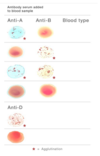Lab Quiz 1: Labs 1, 2, 3 Flashcards
(85 cards)
3 factors that determine the quality of a microscopic image
- Contrast: distinguish objects, such as cells, from the background
- Magnification: increase in image size
- Resolution: distinguish fine detail
4 objective lens sizes
- 4X, 10X, 40X, and 100X
- Note
- When focusing on a slide, start on the scanning, or low power, objective lens
- The lower the power objective, the greater the field of view. The field of view is the amount of the slide you are able to see through the eyepiece.
ABO system of blood typing
- Describe
- How is type determined?
- Determined by the presence or absence of specific surface antigens on RBCs
- A: when a blood cell has the A antigen on its surface
- B: when a blood cell has the B antigen
- O: neither A or B antigens are present
- AB: when both A and B antigens are present
Agglutination
- When the cells clump together due to the antibody / antigen interaction
Antibodies
- Immune system proteins that binds to antigens to aid in creating immune responses
Antigen
- Any substance that is capable of causing an immune reaction
- Usually proteins, glycoproteins, or glycolipids
Impact of Aperture
- As you move the aperture to decrease the light to the slide, the contrast increases
- As you move the aperture to increase the light to the slide, the contrast decreases
Note: The sliding bar on the condenser lens is the aperture
Basophils
- Indication of
- Appearance (nucleus & color)
- Frequency in WBCs
- WBC granulocyte
- Fight fungal or bacterial infections and viruses
- Nucleus is usually bilobed
- Black or dark purple granules
- 0-2% of WBCs
- The least abundant in all mammals
Blood
- What is it composed of?
- Liquid connective tissue
- Matrix is composed of plasma surrounding the formed elements
Blood doping
- Describe
- Normal ranges
- Methods used to increase the blood oxygen-carrying capacity
- Ranges
- Male: 14–18 grams Hb/100 mL
- Female: 12–16 grams Hb/100 mL
Blood type identification


How do you convert cm to m?
- cm * 0.01; OR
- cm / 100
Eosinophils
- Indication of
- Appearance (nucleus & color)
- Frequency in WBCs
- WBC granulocyte that promotes inflammation
- Parasitic infection, allergic reaction, cancer
- Nucleus is usually bilobed
- Bright red granules
- 0-5% of WBCs
Fields of study where a microscope is a necessary tool
- Cytology: the study of cells
- Histology: the study of tissues
- Pathology: the study of disease
Formed elements
- Platelets (thrombocytes)
- RBCs (erythrocytes)
- WBCs (leukocytes)
- Granular
- Basophils
- Eosinophils
- Neutrophils
- Agranular
- Lymphocytes
- Monocytes
- Granular
Hematocrit (HCT)
- Description
- Indication of
- Generally accepted ranges
- Measures packed RBC cell volume
- Determined by separating the formed elements from the plasma
- Indication of high altitude, elevated testosterone levels, blood doping
- Ranges
- Adult males: 42% – 52%
- Adult females: 37% – 47%
Hematocrit formula
(RBC x MCV) / 10 = HCT
Note: MCV is the average volume (size) of the patient’s RBCs
Hematology
The study of the blood and the organs that produce it
Hemoglobin
- Describe
- How is it measured?
- One measure of the oxygen-carrying capacity of the blood
- RBCs are about ⅓ hemoglobin
- Measured using a hemoglobinometer
How do the coarse and fine focus knobs work on a Brightfield microscope?
They move the stage up and down, allowing the user to move the slide into focus
How do you adjust field of view?
- Top stage knob moves the stage forward and back
- Bottom stage knob moves it side-to-side
How do you read a graduated cylinder?
- Water adheres to the glass walls of a graduated cylinder, creating a curved appearance termed a meniscus
- Accurate volume measurements are taken at the bottom of the meniscus with your eye level parallel to the meniscus
How is blood type determined?
- By the antigens that are present on the surface of RBCs
- ABO blood type is determined by the presence of A, B, both (AB), or neither (O) of the A or B antigens
- Rh blood type is determined by the presence of (+) or lack of (-) the D antigen
How to focus on a specimen
- Place the slide on the stage
- Make sure that the scanning (4x) objective is in place
- Using the coarse adjustment knob, adjust the stage to its highest position (closest to the specimen)
- Using the mechanical stage place the specimen in the path of light
- Looking through the ocular, first use the coarse adjustment knob to bring the specimen in view. The ocular is usually 10-15x
- Use the fine adjustment knob to focus more clearly on the specimen
- Only now can you move up to the next objective (low power 10x)
- Repeat steps 7 and 8 to move to the 40x (high dry) objective
*Remember to use the fine adjustment knob only for both the 10x and 40x objectives.





















